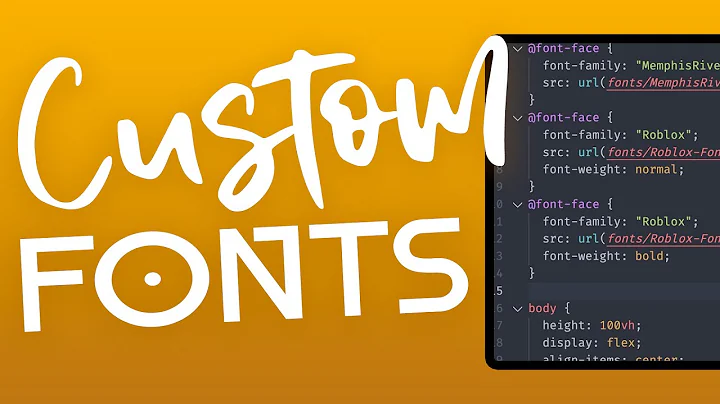How do I install a custom font on an HTML site
Solution 1
Yes, you can use the CSS feature named @font-face. It has only been officially approved in CSS3, but been proposed and implemented in CSS2 and has been supported in IE for quite a long time.
You declare it in the CSS like this:
@font-face { font-family: Delicious; src: url('Delicious-Roman.otf'); }
@font-face { font-family: Delicious; font-weight: bold; src: url('Delicious-Bold.otf');}
Then, you can just reference it like the other standard fonts:
h3 { font-family: Delicious, sans-serif; }
So, in this case,
<html>
<head>
<style>
@font-face { font-family: JuneBug; src: url('JUNEBUG.TTF'); }
h1 {
font-family: JuneBug
}
</style>
</head>
<body>
<h1>Hey, June</h1>
</body>
</html>
And you just need to put the JUNEBUG.TFF in the same location as the html file.
I downloaded the font from the dafont.com website:
http://www.dafont.com/junebug.font
Solution 2
You can use @font-face in most modern browsers.
Here's some articles on how it works:
- http://webdesignerwall.com/general/font-face-solutions-suggestions
- http://webdesignerwall.com/tutorials/css3-font-face-design-guide
Here is a good syntax for adding the font to your app:
Here are a couple of places to convert fonts for use with @font-face:
- http://www.fontsquirrel.com/fontface/generator
- http://fontface.codeandmore.com/
- http://www.font2web.com/
Also cufon will work if you don't want to use font-face, and it has good documentation on the web site:
Solution 3
For the best possible browser support, your CSS code should look like this :
@font-face {
font-family: 'MyWebFont';
src: url('webfont.eot'); /* IE9 Compat Modes */
src: url('webfont.eot?#iefix') format('embedded-opentype'), /* IE6-IE8 */
url('webfont.woff2') format('woff2'), /* Super Modern Browsers */
url('webfont.woff') format('woff'), /* Pretty Modern Browsers */
url('webfont.ttf') format('truetype'), /* Safari, Android, iOS */
url('webfont.svg#svgFontName') format('svg'); /* Legacy iOS */
}
body {
font-family: 'MyWebFont', Fallback, sans-serif;
}
For more info, see the article Using @font-face at CSS-tricks.com.
Solution 4
Try this
@font-face {
src: url(fonts/Market_vilis.ttf) format("truetype");
}
div.FontMarket {
font-family: Market Deco;
} <div class="FontMarket">KhonKaen Market</div>vilis.org
Solution 5
If you are using an external style sheet, the code could look something like this:
@font-face { font-family: Junebug; src: url('Junebug.ttf'); }
.junebug { font-family: Junebug; font-size: 4.2em; }
And should be saved in a separate .css file (eg styles.css). If your .css file is in a location separate from the page code, the actual font file should have the same path as the .css file, NOT the .html or .php web page file. Then the web page needs something like:
<link rel="stylesheet" href="css/styles.css">
in the <head> section of your html page. In this example, the font file should be located in the css folder along with the stylesheet. After this, simply add the class="junebug" inside any tag in your html to use Junebug font in that element.
If you're putting the css in the actual web page, add the style tag in the head of the html like:
<style>
@font-face { font-family: Junebug; src: url('Junebug.ttf'); }
</style>
And the actual element style can either be included in the above <style> and called per element by class or id, or you can just declare the style inline with the element. By element I mean <div>, <p>, <h1> or any other element within the html that needs to use the Junebug font. With both of these options, the font file (Junebug.ttf) should be located in the same path as the html page. Of these two options, the best practice would look like:
<style>
@font-face { font-family: Junebug; src: url('Junebug.ttf'); }
.junebug { font-family: Junebug; font-size: 4.2em; }
</style>
and
<h1 class="junebug">This is Junebug</h1>
And the least acceptable way would be:
<style>
@font-face { font-family: Junebug; src: url('Junebug.ttf'); }
</style>
and
<h1 style="font-family: Junebug;">This is Junebug</h1>
The reason it's not good to use inline styles is best practice dictates that styles should be kept all in one place so editing is practical. This is also the main reason that I recommend using the very first option of using external style sheets. I hope this helps.
Related videos on Youtube
adam
Gone Lean - founder of @neighborrow - now spend most of my time teaching and mentoring. Trying my own side projects and experiments with code to stay in the game. http://www.solsisters.groupshot.us/slider/index.php
Updated on April 12, 2022Comments
-
adam about 2 years
I am not using flash or php - and I have been asked to add a custom font to a simple HTML layout. "KG June Bug"
I have it downloaded locally - is there a simple CSS trick to accomplish this?
-
adam over 12 yearssorry if it's "homework" what would the code look like if I used this JUNEBUG font for just the plain text
-
 Julien Bourdon over 12 yearsI didn't know you could do that. Does it work in other browsers too?
Julien Bourdon over 12 yearsI didn't know you could do that. Does it work in other browsers too? -
 Black over 8 yearsDoes not work for me, my font is in the same folder as my php page.
Black over 8 yearsDoes not work for me, my font is in the same folder as my php page. -
 Alex Semeniuk about 7 years@Black path specified in
Alex Semeniuk about 7 years@Black path specified inurlis relative to where your css file is at. -
Arcath over 6 yearsYou should really define it as a
font-facein CSS instead of requiring a ttf file. -
Abbass Sharara over 6 yearsit is not required to do so you can simply do it like this I always do it in the two ways and both works
-
 Antonio about 4 years@Arcath why is better to use font-face?
Antonio about 4 years@Arcath why is better to use font-face?





